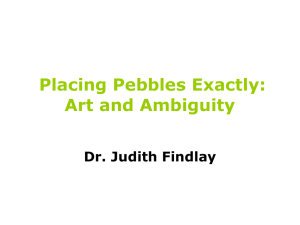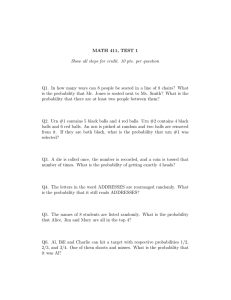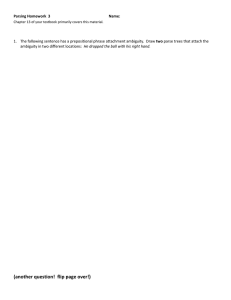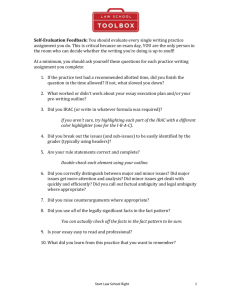T A N C
advertisement
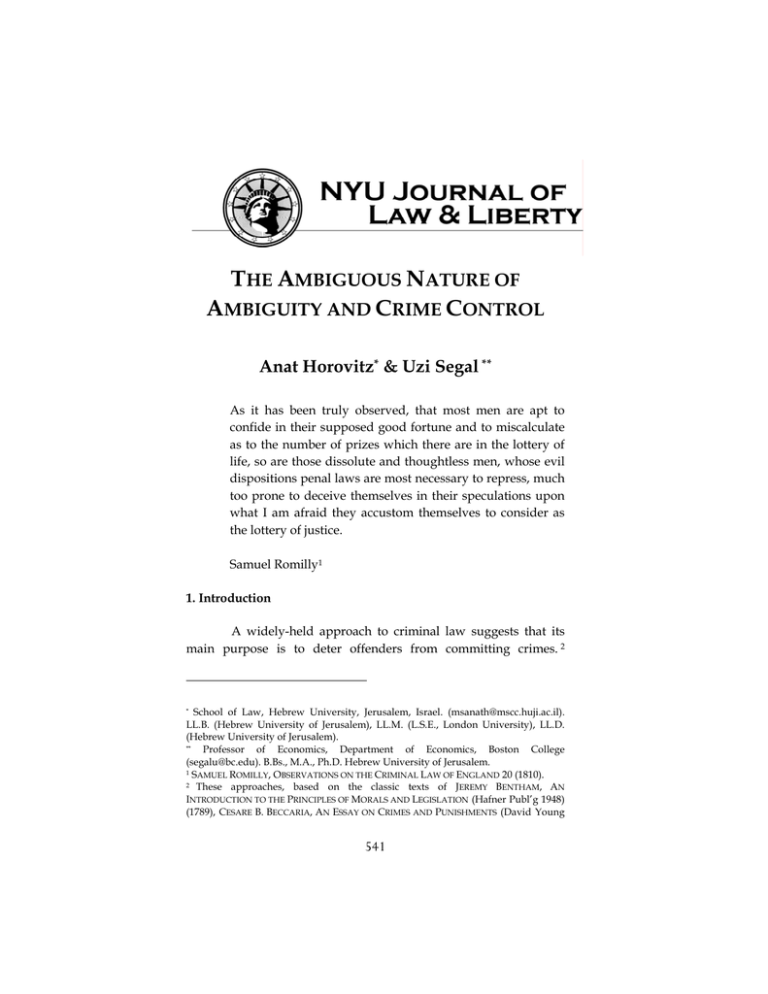
THE AMBIGUOUS NATURE OF AMBIGUITY AND CRIME CONTROL Anat Horovitz* & Uzi Segal ** As it has been truly observed, that most men are apt to confide in their supposed good fortune and to miscalculate as to the number of prizes which there are in the lottery of life, so are those dissolute and thoughtless men, whose evil dispositions penal laws are most necessary to repress, much too prone to deceive themselves in their speculations upon what I am afraid they accustom themselves to consider as the lottery of justice. Samuel Romilly1 1. Introduction A widely-held approach to criminal law suggests that its main purpose is to deter offenders from committing crimes. 2 School of Law, Hebrew University, Jerusalem, Israel. (msanath@mscc.huji.ac.il). LL.B. (Hebrew University of Jerusalem), LL.M. (L.S.E., London University), LL.D. (Hebrew University of Jerusalem). ** Professor of Economics, Department of Economics, Boston College (segalu@bc.edu). B.Bs., M.A., Ph.D. Hebrew University of Jerusalem. 1 SAMUEL ROMILLY, OBSERVATIONS ON THE CRIMINAL LAW OF ENGLAND 20 (1810). 2 These approaches, based on the classic texts of JEREMY BENTHAM, AN INTRODUCTION TO THE PRINCIPLES OF MORALS AND LEGISLATION (Hafner Publ’g 1948) (1789), CESARE B. BECCARIA, AN ESSAY ON CRIMES AND PUNISHMENTS (David Young * 541 542 NYU Journal of Law & Liberty [Vol. 2:541 According to this approach, when society is indifferent between several modes of law enforcement, or between rules that govern criminal proceedings, it should pick those most detested by potential criminals. Alternatively, if different crime control methods lead to the same level of deterrence, society is free to pick the one it prefers. Thus, for example, if different combinations of the probability of detection, prosecution, conviction, and penalty lead to the same crime rate, and no other issues are of concern, society should pick the least expensive option, according to the costs incurred in each stage of the criminal process. In order to enhance deterrence, careful attention must be given to the many factors that influence a person's decision to commit a crime. 3 One such factor is the existence of ambiguity. According to several models in economics and psychology, most decision makers prefer to avoid probability ambiguity—that is, they prefer to avoid risky situations in which they are uncertain about the exact values of the probabilities. Ample empirical and theoretical support exists for this phenomenon. 4 Thus, assuming that society regards deterrence of criminal activity as its goal, we should confront criminals with ambiguous situations. This basic insight has been applied in the legal literature, in a limited number of contexts.5 The main contribution in this article is our claim that creating ambiguity may not always be the best strategy from the standpoint of deterrence. More specifically, we claim that closer attention must be given to the nature of the ambiguity—i.e. whether it refers to highly likely or highly unlikely events, and whether it ed. & trans., Hackett Publ’g 1986) (1809), were revived in modern times by Gary Becker, Crime and Punishment: An Economic Approach, 76 J. POL. ECON. 169 (1968). 3 See, for example, RICHARD POSNER, ECONOMIC ANALYSIS OF LAW 219-227 (6th ed. 2003) for a description of some of the “classic” factors. 4 See, e.g., Colin Camerer & Martin Weber, Recent Developments in Modeling Preferences: Uncertainty and Ambiguity, 5 J. RISK & UNCERTAINTY 325 (1992). 5 See, e.g., Alon Harel & Uzi Segal, Criminal Law and Behavioral Law and Economics: Observations on the Neglected Role of Uncertainty in Deterring Crime, 6 AMER. L. & ECON. REV. 276 (1999); Uzi Segal & Alex Stein, Ambiguity Aversion and the Criminal Process, 81 NOTRE DAME L. REV. 1495 (2006). 2007] Ambiguity and Crime Control 543 concerns desirable or undesirable outcomes. We base this claim on several recent empirical studies, and demonstrate its usefulness in explaining legal phenomena through an example drawn from criminal procedure. We are confident, however, that the insights from this refined attitude towards ambiguity, can also contribute to the understanding of other legal arrangements in different branches of law.6 The empirical studies we rely upon tested volunteers in artificially constructed decision-making situations. Can these insights be applied to individuals contemplating crime? One of the many difficulties that arise in this context is that there is some support for the claim that criminals may be less averse to ambiguity than the population at large. According to a study conducted by Lauriola and Levin, 7 a positive correlation exists between risk aversion and ambiguity aversion; thus, if persons are less riskaverse than average decision makers, they might also be less averse to ambiguity. One of the most cited theories in criminology claims that the main predictor of delinquency and related deviant behaviors at the individual level is low self-control.8 According to this theory, low self-control is identified by six main traits, one of them being risk seeking. 9 Scores of studies that have tested this theory in different settings have established in particular the correlation between risk seeking and deviant behavior.10 Therefore, the degree to which potential offenders' decision-making abides by the general findings of the literature we rely upon is an open and thus far neglected issue, which no doubt requires further research. For the purposes of this article and the nuanced version of We hope to substantiate this claim in an expanded future article. Marco Lauriola, & Irwin P. Levin, Relating Individual Differences in Attitude toward Ambiguity to Risky Choices, 14 J. BEHAV. DECISION MAKING 107 (2001). 8 See, e.g., MICHAEL R. GOTTFREDSON & TRAVIS HIRSCHI, A GENERAL THEORY OF CRIME (1990). 9 Id. at 89-91. 10 See, e.g., Bruce J. Arneklev, Harold G. Grasmick, Charles R. Tittle, Low Self control and Imprudent Behavior, 9 J. QUANTITATIVE CRIMINOLOGY 225, 228 (1993). 6 7 544 NYU Journal of Law & Liberty [Vol. 2:541 ambiguity we employ, however, we assume that whatever differences may exist between the decision-making processes of the experimental subjects and those of potential offenders, they are small enough to be set aside and in any case, are immaterial to the issue we wish to highlight.11 In the following section we introduce the general notion of ambiguity and of subjects' attitudes towards ambiguity. In particular, we discuss different types of ambiguity that depend on the underlying likelihoods of the different events. This notion is supported by some experimental evidence, discussed in the third section. A suggested application, relating to the criminal process, is presented in the forth section. We end our article with a short conclusion. 2. Ambiguity Daniel Ellsberg suggests the following thought experiment.12 A subject is confronted with a simple dilemma. There are two urns, A and B. Urn A contains one hundred balls. Exactly fifty of the balls are red, and the other fifty balls are blue. One ball is picked at random, and the subject is asked to guess its color. If the subject guesses correctly, he wins $100; if he guesses incorrectly, he wins zero. The bet costs nothing. Should the subject prefer to bet that the ball is red, the ball is blue, or should he be indifferent? Obviously, the correct answer is “indifferent.” A preference for one color over the other would imply that the decision maker is willing to pay a premium to switch to that color—which, of course, is not going to change his chances. Urn B also contains one hundred balls. In this case, all that is known is that each of the balls it contains is either red or blue, but 11 In a general sense, our claim that confronting potential offenders with ambiguous situations may not lead to optimal deterrence becomes even stronger if it is indeed the case that potential criminals are less ambiguity averse than the rest of the population. However our claim is far more particular and calls for taking into account the underlying probabilities, in a manner which will shortly be clarified. 12 Daniel Ellsberg, Risk, Ambiguity, and the Savage Axioms, 75 Q. J. ECON. 643 (1961). 2007] Ambiguity and Crime Control 545 it is unknown how many balls are of each color. One ball is picked at random. Here too the decision maker is to guess the color of the ball and the bet costs nothing. If he guesses correctly, he wins $100. If not, he wins zero. Should the subject prefer to bet that the color of the ball is red, blue, or should he be indifferent? In this case it is less obvious than before what the correct answer is, or whether a correct answer even exists. Yet one can present a good argument that the correct answer is still “indifferent.” These arguments are mainly based on the observation that in urn B (as in urn A), the situation is symmetric in the sense that whatever one can say about the color red, one can also say about the color blue, and vice versa. For example, there is no reason to believe that the composition “63 red, 37 blue,” is more or less likely than the composition “37 red, 63 blue.” The interesting question, however, is linked to Ellsberg’s third example.13 Suppose a subject decides to bet on red in urn A, and on red in urn B. If he is allowed to choose the urn, should he prefer to bet on red in urn A, on red in urn B, or should he be indifferent? Following the analysis so far, it seems possible to suggest a correct answer. As the decision maker is indifferent between red and blue in urn A, we can conclude that he believes the probability of each of the two colors to be 50%. According to this logic, the subject’s indifference between the two colors of urn B should lead us to the same conclusion: namely, that he believes both colors in the urn to have the same probability. Since no other color is possible, it follows that here, too, the decision maker believes that the probability of each of the two colors in urn B is 50%. Since there is no difference between the two urns; the “rational” decision maker should be indifferent between playing red in urn A, or playing red in urn B. 13 Id. at 650-651. 546 NYU Journal of Law & Liberty [Vol. 2:541 Unsurprisingly, decision makers are not indifferent between these two urns, and experiments have demonstrated that most decision makers prefer to bet on a color out of urn A, rather than urn B.14 The intuition seems clear enough. “Why should I bet on the color of a ball in an urn that may be full (or mostly full) with balls of the other color?” the decision maker asks himself. “I'd rather stick to the known situation and choose to play on urn A.” The economic and psychological literature refer to this phenomenon as “ambiguity aversion.” There are several theoretical explanations why decision makers in these situations exhibit ambiguity aversion. 15 For the purposes of this article, however, we will focus on decision makers' actual behavior, and particularly on the question: Do decision makers always reject ambiguous options? In evaluating the empirical evidence, we will concentrate on the specific nature of the ambiguity. As mentioned earlier, the exact composition of urn B above is unknown, but the information provided about this urn is symmetric in the sense that any argument in favor of one color, can be made with respect to the other color. Therefore, it seems irrational to prefer one color to the other. But what if the ambiguity is not symmetric, especially in situations when the expected probability is close to zero or to one? Consider the following situation. 16 Urn C contains one thousand balls, numbered from one to one thousand. One ball is picked at random, and if the subject correctly guesses its number, he wins a prize (say, $10,000). See Camerer & Weber, supra note 3. See David Schmeidler, Subjective Probability and Expected Utility Without Additivity, 57 ECONOMETRICA 571 (1989); Itzhak Gilboa, Expected Utility with Purely Subjective Non-Additive Probabilities, 16 J. MATH. ECON. 65-88 (1987); Uzi Segal, The Ellsberg Paradox and Risk Aversion: An Anticipated Utility Approach, 28 INT. ECON. REV. 175 (1987); Itzhak Gilboa & David Schmeidler, Maxmin Expected Utility with a Non-Unique Prior, 18 J. MATH. ECON. 141 (1989); Yoram Halevy & Vincent Feltkamp, A Bayesian Approach to Uncertainty Aversion, 72 REVIEW ECON. STUD. 449 (2005) 16 This thought experiment was also suggested by Ellsberg, supra note 11. See also Selwyn W. Becker & Fred O. Brownson, What Price Ambiguity? Or the Role of Ambiguity in Decision Making, 72 J. POLITICAL ECONOMY 62 (1964). 14 15 2007] Ambiguity and Crime Control 547 Urn D is similar to urn C. It too contains one thousand balls, and each of these balls carries an integer between one and one thousand (inclusive). In urn D, however, the numbers do not necessarily differ from one ball to another—it is even possible that all balls carry the same number. One ball is picked from urn D at random, and if the subject correctly guesses its number he wins $10,000. From a statistical point of view, urns C and D are identical; they both offer a one-in-one-thousand chance of winning $10,000. However, although the composition of urn D is ambiguous while the composition of urn C is known, it is much less obvious that decision makers will pick the unambiguous urn in this situation. In fact, several experiments, discussed below, demonstrate that decision makers attach great significance to the fact that the unknown probability is small. Another question is whether decision makers prefer to know exact probabilities when losses, rather than gains, are involved. 17 Consider the following problem. Urn E contains one hundred balls. These include exactly ten balls of each of ten different colors c1 ,..., c10 . One ball is drawn at random, and unless the subject correctly guesses its color, he will lose $1,000. Similarly, urn F contains one hundred balls. However, in this urn each ball may be any one of the ten colors c1 ,..., c10 . One ball is drawn at random, and unless the subject correctly guesses its color, he will lose $1,000. Should the subject prefer to play urn E or urn F (assuming that he must play one of them)? Empirical evidence indicates that, when confronted with choices like the one described in the preceding paragraph, decision 17 The fact that decision makers’ attitude towards unknown outcomes may depend on whether the outcome is “good” or “bad” is well-documented within the analysis of risk. See, e.g., Daniel Kahneman & Amos Tversky, Prospect Theory: An Analysis of Decision Under Risk, 47(2) ECONOMETRICA 263 (1979). 548 NYU Journal of Law & Liberty [Vol. 2:541 makers often act as ambiguity seekers18. Therefore, they tend not to reject the ambiguous option, i.e. urn F in the above example, in similar situations. Needless to say that if decision makers under such circumstances are indeed ambiguity seekers, legal arrangements should anticipate and account for such behavior. In the next section we survey some of the empirical literature concerning ambiguity seeking. 3. Empirical Evidence Ellsberg's intuition regarding ambiguity aversion has been examined in different contexts, and many studies have found empirical support for decision makers’ preference for urn A over urn B in the circumstances described in the first part of the previous section.19 Other experiments surveyed not only decisions between urns with balls of two different colors, but also decisions between urns with balls of three different colors. These experiments further highlight the complex nature of ambiguity aversion, as the following example demonstrates. An urn contains 90 balls, of which exactly 30 are known to be red. The other 60 balls are either blue or green, but the exact distribution of these two colors between those balls is unknown. Consider the four options depicted in the table below. In each case, one ball is picked at random out of the urn. The table describes the payments to the subject if he is successful in his bet. 18 See, e.g., W. Kip Viscusi & Harrell Chesson, Hopes and Fears: The Confliction Effects of Risk Ambiguity, 47 THEORY & DECISION 153 (1999). 19 See Kenneth R. MacCrimmon, & Stig Larsson, Utility Theory: Axioms Versus ‘Paradoxes,’ in EXPECTED UTILITY HYPOTHESES AND THE ALLAIS PARADOX 333 (Maurice Allais & Ole Hagen eds., 1979) for an early collection of such experiments. 2007] Ambiguity and Crime Control I II III IV Red 100 0 100 0 Blue 0 100 0 100 549 Green 0 0 100 100 Most subjects prefer to gamble on option I rather than on option II, but they prefer gambling on option IV rather than on option III. The intuition seems clear. The probabilities regarding options I and IV are known (1/3 and 2/3, respectively), whereas the probabilities regarding options II and III equal 1/3 and 2/3 only on average. However, these preferences are inconsistent with any coherent set of probabilities. Denote the probabilities of the ball being red, blue, and green by α , β , and γ , respectively. Obviously, α + β +γ =1 The preferences for option I over option II imply that: α >β Whereas the preferences for option IV over option III imply: β +γ >α +γ Hence: β >α , This, of course, is a contradiction. 550 NYU Journal of Law & Liberty [Vol. 2:541 This and several other experiments just now described are surveyed in detail by Camerer and Weber. 20 Further experimentation, however, has shown that decision makers do not always reject ambiguity. Viscusi and Chesson21 summarize earlier studies, and conclude that for gains, decision makers are averse to ambiguity with respect to high probabilities, but seek ambiguity with respect to low probabilities. On the other hand, for losses, subjects are averse to ambiguity with respect to low probabilities, but they prefer ambiguity with respect to high probabilities. In their paper, Viscusi and Chesson describe experiments where business owners were exposed to ambiguity concerning climate change. Their experiments reinforced the results of the earlier studies. 4. An Application When contemplating upon whether or not to commit a crime, most rational decision makers consider, among other factors, the prescribed sanction for the offence and the probability the sanction will be inflicted upon them. Harel and Segal argue that since decision makers are risk-seeking with respect to losses, and ambiguity-averse with respect to probabilities, the optimal policy of the criminal justice system from the perspective of deterrence, is to promote “certainty with respect to the size of the sanction and uncertainty with respect to the probability of detection and conviction.” 22 In the following paragraphs we argue that this analysis is overly simplistic, and does not account for the recent studies in economics and psychology we described above, regarding the impact of ambiguity on subjects in cases where the probability of the occurrence of the underlying event is particularly small or large. Consider, for example, a crime for which there is a fixed sanction, denoted x. In other words, if convicted, a person will face Camerer & Weber, supra note 3. Viscusi & Chesson, supra note 17. 22 Harel & Segal, supra note 4, at 277. 20 21 2007] Ambiguity and Crime Control 551 this sanction with absolute certainty. When reflecting upon whether or not to commit the crime, the decision maker has to assess the probability that the sanction will be imposed on him. Generally speaking, if he commits the crime, two events must occur before he will be punished: 1. 2. Event A (detection): The investigative authorities will discover that he committed the crime and will bring charges against him. Event B (conviction): The decision maker will be convicted at the conclusion of his trial. Denote the decision maker’s status quo situation by z and his situation if the crime goes unpunished by y. It is obvious that the decision maker prefers y to z, for otherwise he will never commit the crime. Assume further that the decision maker prefers z to x, the penalty for committing the crime. Accordingly, the decision maker has to choose between receiving z for certain (if he does not commit the crime), or participating in the following lottery: 552 NYU Journal of Law & Liberty [Vol. 2:541 Not A A y B x Not B y Figure 1: The two-stage lottery This two stage lottery can be interpreted in two different ways: 1. The decision maker will receive x if the events “A and B” ( A I B ) occur, and y in all other cases (i.e. if either event A or event B does not occur). Formally, this is the nature of the lottery: L = ( x, A I B; y , not A I B ) 2. If event A happens, the decision maker participates in a second lottery: “x if B happens, y if B does not happen.” If A does not happen, he will receive y. According to this interpretation, the lottery can be expressed in the following way: (( x, B; y , not B ), A; y, not A) Denote by w the certainty equivalent of the lottery ( x, B; y, not B ) —that is, define outcome w such that the 2007] Ambiguity and Crime Control 553 decision maker is indifferent between facing the lottery ( x, B; y, not B ) and receiving w for certain. The utility from w is subjective, and changes from one person to another. As x is a bad outcome and y is a good outcome, w may be a better or worse outcome than the status quo z, depending on x, y, and B, and of course, on the preferences of the decision maker. Thus, the lottery described in figure 1 can also be presented as the lottery: L' = ( w, A; y, not A) Empirical evidence suggests that there is no reason to believe that decision makers are indifferent between the lotteries L and L’. Moreover, these experiments suggest that the true evaluation depicted in Figure 1 is the latter rather than the former.23 In other words, decision makers tend to consider the two stages of the lottery as separate, and therefore may well have different attitudes towards the unique ambiguities surrounding each stage. In the present context, we argue that a potential lawbreaker’s attitude towards ambiguity during the investigative stage of the criminal process differs from his attitude towards ambiguity during the trial stage, in at least one important sense— the underlying probabilities surrounding each stage of the process. When a potential offender decides to commit a crime, he evaluates the probability of being apprehended (Event A), independently of his chances of being convicted and thus punished (Event B). Generally speaking, the decision maker does not know the exact probability of either detection or conviction, although he does have some information regarding the two events. He knows that the probability of being convicted, if prosecuted, is much higher than the probability of being detected and charged with committing the crime. Moreover, it is a commonly shared Yoram Halevy, Ellsberg Revisited: An Experimental Study, 75(2) ECONOMETRICA 503536 (2007). 23 554 NYU Journal of Law & Liberty [Vol. 2:541 observation that the authorities are only aware of a fraction of the offenses committed nationwide, and charge the offender in only a few of these known cases. Therefore the prior probability of "detection," as defined in the above description of Event A, is relatively low.24 On the other hand, it is widespread wisdom that the vast majority of those who are criminally indicted either file a guilty plea or are found guilty by the courts.25 Therefore the prior probability of conviction, as defined in the above description of Event B, is undoubtedly high. Criminals, of course, consider punishment to be a loss. As mentioned earlier, experimental results demonstrate that when it comes to losses, decision makers are ambiguity-averse with respect to low probabilities, but ambiguity-seeking with respect to high probabilities. 26 It follows that in order to obtain maximum deterrence, society should enhance the ambiguity of less probable events that lead to loss, and reduce the ambiguity of highly probable events that lead to loss. In the present context, society ought to make the low probability of detection ambiguous, and to keep the high probability of court conviction unambiguous. 24 The Uniform Crime Reports, compiled by the FBI from data provided by nearly 17,000 law enforcement agencies, regard an offense as “cleared” when a person has been arrested, charged with the commission of the offence, and turned over to the court for prosecution; or, in exceptional cases, when the offender was identified and evidence was collected to make a charge against him, but for circumstances outside the control of the law enforcement agency (such as death of the offender), the offender was not prosecuted. The data for 2005 indicates that nationwide, only 45.5% of violent crimes and 16.3% of property crimes were cleared. U.S. DEPT. OF JUSTICE FEDERAL BUREAU OF INVESTIGATION, CRIME IN THE UNITED STATES 2005: CLEARANCES, http://www.fbi.gov/ucr/05cius/offenses/clearances/index.html (last visited Apr. 24, 2007). Since clearance rates only apply to offenses reported to the police and also include exceptional cases in which the offender was not prosecuted, it is clear that the detection rates (as defined in the article) are lower than the clearance rates cited above. 25 Of the defendants charged in U.S. District Courts in 2003, 89.1% were convicted, down from 89.3% of defendants charged in 2002, and up from 88.8% of defendants charged in 2001. SOURCEBOOK OF CRIMINAL JUSTICE STATISTICS ONLINE, tbl. 5.17, http://www.albany.edu/sourcebook/tost_5.html#5_n (last visited Apr. 24, 2007). 26 See Viscusi & Chesson, supra note 17. 2007] Ambiguity and Crime Control 555 This intuition is consistent with both enforcement practices and trial procedures. Police investigations are usually conducted under a thick veil of secrecy: enforcement practices attempt to instill a fear of detection while obscuring authorities’ actual detection capabilities. Thus, for example, traffic-control agencies around the world have placed fake cameras at crossroads and positioned dummy police cars on the margins of major highways, in order to enhance the ambiguity of detection. 27 Customs officials conduct random searches and inquiries in airports28 and similar practices exist in other forms of law enforcement.29 When one moves to trial procedure, however, a very different picture emerges. The constitution grants the accused the right to a public trial, and conducting criminal proceedings in open court is regarded as one of the most fundamental principles in criminal procedure.30 As many commentators point out, the public nature of the criminal trial serves not only to protect defendants from malicious prosecutions, but also to educate the public about 27 For example, the Israel Police use “scarecrows” that “simulate police radar broadcasts,” in addition to employing 100 dummy camera boxes, which are “intended to serve the purpose of deterring drivers from committing offences.” Israel Police, Equipment and Technology, http://www.police.gov.il/english/Traffic/equipment/xx_en_tr_equipment.asp (last visited Apr. 24, 2007). Ukraine, Japan and several other countries have opted for fake police cars. Ukraine’s Dummy Police Cars, BBC NEWS, Mar. 5, 2003 http://news.bbc.co.uk/1/hi/world/europe/2820393.stm. 28 One of the elements of the operational vision of the U.S. Customs and Border Protection division of the U.S. Department of Homeland Security is to maintain deterrence. Amongst other techniques, this is achieved by inspecting people and goods according to their “assessed level of risk,” which is based on factors undisclosed to the public. U.S. CUSTOMS AND BORDER PROTECTION, SECURING AMERICA’S BORDERS AT PORTS OF ENTRY (2006), http://www.cbp.gov/linkhandler/cgov/newsroom/fact_sheets/port_security/sec ure_america.ctt/secure_america.pdf. 29 One notable example is the practice of the IRS to audit only a certain percentage of all tax returns. 30 “One of the most conspicuous features of English justice, that all judicial trial are held in open court, to which the public have free access… appears to have been the rule in England from time immemorial.” Richmond Newspapers Inc. v. Virginia, 448 U.S. 555, 566-67 (1980). (citing The Book of English Law 73-74 (6th ed. 1967)). 556 NYU Journal of Law & Liberty [Vol. 2:541 the criminal law and its method of enforcement. 31 The rules governing criminal trials are comprehensive and detailed, and little ambiguity exists regarding the natural course of the proceedings. It seems clear that these contrasting approaches to the two stages of the lottery depicted in Figure 1, create a great amount of ambiguity at the first stage of the lottery, while minimizing ambiguity at the second stage. 5. Conclusion Ambiguity is, itself, an ambiguous notion, which must be treated with caution. In certain contexts, when loss is involved and the underlying probabilities are high, subjects tend to seek it. In different situations, when loss is involved and the underlying probabilities are low, subjects are typically averse to it. As we have demonstrated in our short article, this insight can explain, and perhaps justify, various legal arrangements. Undoubtedly, more research is needed regarding the different ways in which ambiguity affects decision makers, and the manner by which this concept can be utilized within a legal framework. 31 See, e.g., Laurence H. Tribe, Trial by Mathematics: Precision and Ritual in the Legal Process, 84 HARV. L. REV 1329, 1391-92 (1971); Gary Goodpaster, On the Theory of American Adversary Criminal Trial, 78 J. CRIM. L. & CRIMINOLOGY 118 (1987).



